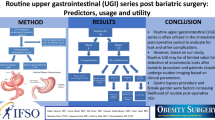Abstract
Background
The utility of routine upper gastrointestinal (UGI) studies after laparoscopic Roux-en-Y gastric bypass (LRYGB) is a matter of great debate. Because the morbidity and mortality rates associated with an unrecognized postoperative leak are high after LRYGB, diagnosis of a postoperative leak earlier would be of benefit. Clinical signs, however, may predict the diagnosis of a postoperative leak more often. This study explored the hypothesis that UGI studies are more predictive than clinical signs for the early diagnosis of a postoperative leak after LRYGB.
Methods
All patients who underwent LRYGB at the authors’ institution were included in this study. Charts were reviewed to examine immediate clinical signs (heart rate, temperature, and white blood cell count within the first 24 h), UGI studies, and clinical course. Sensitivity, specificity, positive predictive value, negative predictive value, and efficiency of clinical signs and UGI studies were calculated.
Results
This study included 245 patients with a 3% rate of leak. The positive and negative predictive value of UGI studies were 67% and 99%, respectively. Only an elevated white blood count had a better predictive value (100% for negative predictive value). The efficiency of UGI studies (98%) was better than that of heart rate (83%), white blood count (8%), or temperature (95%).
Conclusions
According to our data, UGI studies are the most predictive of an early leak diagnosis. Clinical signs alone may not be as useful in predicting leaks early after laparoscopic gastric bypasses. Routine early postoperative UGI studies are a reasonable approach to predicting leaks after LRYGB.
Similar content being viewed by others
References
Flegal KM, Carroll MD, Ogden CL, Johnson CL (2002) Prevalence and trends in obesity among U.S. adults, 1999–2000. JAMA 288: 1723–1727
Buchwald H, Avidor Y, Braunwald E, Jensen MD, Pories W, Fahrbach K, Schoelles K (2004) Bariatric durgery: a systematic review and meta-analysis. JAMA 292: 1724–1737
Maggard MA, Shugarman LR, Suttorp M, Maglione M, Sugarman HJ, Livingston EH, Nguyen NT, Li Z (2005) Meta-analysis: surgical treatment of obesity. Ann Intern Med 142: 547–559
Sjostrom L, Lindroos AK, Peltonen M, Torgerson J, Bouchard C, Carlsson B, Dahlgren S, Larsson B (2004) Lifestyle, diabetes, and cardiovascular risk factors 10 years after bariatric surgery. N Engl J Med 351: 2683–2693
Consensus Development Conference Panel (1991) Gastrointestinal surgery for severe obesity. Consensus Development Conference Statement. Ann Intern Med 115: 956–961
Wittgrove AC, Clark GW, Tremblay LJ (1994) Laparoscopic gastric bypass, Roux-en-Y: preliminary report of five cases. Obes Surg 4: 353–357
Nguyen NT, Ho HS, Palmer LS, Wolfe BM (2000) A comparison study of laparoscopic versus open gastric bypass for morbid obesity. J Am Coll Surg 191: 149–155
Nguyen NT, Goldman C, Rosenquist CJ, Arango A, Cole CJ, Lee SJ, Wolfe BM (2001) Laparoscopic versus open gastric bypass: a randomized study of outcomes, quality of life, and costs. Ann Surg 234: 279–289
Nguyen NT, Lee SL, Goldman C, Fleming N, Arango A, McFall R, Wolfe BM (2001) Comparison of pulmonary function and postoperative pain after laparoscopic versus open gastric bypass: a randomized trial. J Am Coll Surg 192: 469–476
Lujan JA, Frutos MD, Hernandez Q, Liron R, Cuenca JR, Valero G, Parrilla P (2004) Laparoscopic versus open gastric bypass in the treatment of morbid obesity: a randomized prospective study. Ann Surg 239: 433–437
Wittgrove AC, Clark GW (2000) Laparoscopic gastric bypass, Roux-en-Y—500 patients: echnique and results, with 3–60 month follow-up. Obes Surg 10: 233–239
Byrne TK (2001) Complications of surgery for obesity. Surg Clin North Am 81: 1181–1193
Sims TL, Mullican MA, Hamilton EC, Provost DA, Jones DB (2003) Routine upper gastrointestinal Gastrografin swallow after laparoscopic Roux-en-Y gastric bypass. Obes Surg 13: 66–72
Schauer PR, Ikramuddin S, Gourash W, Ramanathan R, Luketich J (2000) Outcomes after laparoscopic Roux-en-Y gastric bypass for morbid obesity. Ann Surg 232: 515–529
Hamilton EC, Sims TL, Hamilton TT, Mullican MA, Jones DB, Provost DA (2003) Clinical predictors of leak after laparoscopic Roux-en-Y gastric bypass for morbid obesity. Surg Endosc 17: 679–684
Fernandez AZ, DeMaria EJ, Tichansky DS, Kellum JM, Wolfe LG, Meador J, Sugerman HJ (2004) Experience with over 3,000 open and laparoscopic bariatric procedures: multivariate analysis of factors related to leak and resultant mortality. Surg Endosc 18: 193–197
Oliak D, Ballantyne GH, Davies RJ, Wasielewski A, Schmidt HJ (2002) Short-term results of laparoscopic gastric bypass in patients with BMI ≥ 60. Obes Surg 12: 643–647
Champion JK, Hunt T, DeLisle N (2002) Role of intraoperative endoscopy in laparoscopic bariatric surgery. Surg Endosc 16: 1663–1665
Gould JC, Garren MJ, Starling JR (2004) Lessons learned from the first 100 cases in a new minimally invasive bariatric surgery program. Obes Surg 14: 618–625
Serafini F, Anderson W, Ghassemi P, Poklepovic J, Murr MM (2002) The utility of contrast studies and drains in the management of patients after Roux-en-Y gastric bypass. Obes Surg 12: 34–38
Marshall JS, Srivastava A, Gupta SK, Rossi TR, DeBord JR (2003) Roux-en-Y gastric bypass leak complications. Arch Surg 138: 520–523
Singh R, Fisher BL (2003) Sensitivity and specificity of postoperative upper GI series following gastric bypass. Obes Surg 13: 73–75
Madan AK, Frantzides CT (2003) Triple staple technique of jejunojejunostomy for laparoscopic gastric bypass. Arch Surg 138: 1029–1032
Lyass S, Khalili TM, Cunneen S, Fujita F, Otsuka K, Chopra R, Lahmann B, Lublin M, Furman G, Phillips EH (2004) Radiological studies after laparoscopic Roux-en-Y gastric bypass: routine or selective? Am Surg 70: 918–921
Esmailzadeh H, Powell W, Lourie D (2004) Use of computed tomography in diagnosis of major postoperative gastrointestinal complications of laparoscopic Roux-en-Y gastric bypass surgery. Am Surg 70: 964–966
Author information
Authors and Affiliations
Corresponding author
Rights and permissions
About this article
Cite this article
Madan, A.K., Stoecklein, H.H., Ternovits, C.A. et al. Predictive value of upper gastrointestinal studies versus clinical signs for gastrointestinal leaks after laparoscopic gastric bypass. Surg Endosc 21, 194–196 (2007). https://doi.org/10.1007/s00464-005-0700-x
Received:
Accepted:
Published:
Issue Date:
DOI: https://doi.org/10.1007/s00464-005-0700-x




